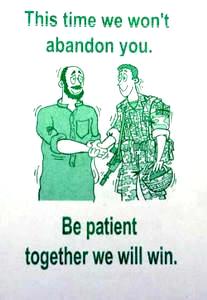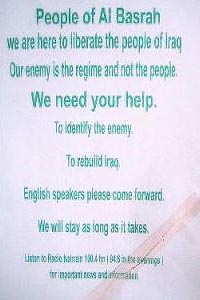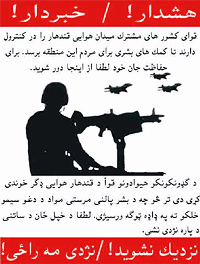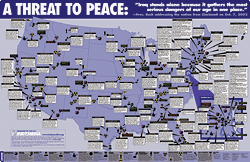Promises
Yeah... um... we believe you. But, um... actually, we really don’t want you here.
More promises and warnings, more images here and here of the millions of U.S. and U.K. leaflets dropped over Iraq.
Media Lies. News at 11.
“On Monday, March 31, the Los Angeles Times published a front-page photograph that had been altered in violation of Times policy.
The primary subject of the photo was a British soldier directing Iraqi civilians to take cover from Iraqi fire on the outskirts of Basra. After publication, it was noticed that several civilians in the background appear twice. The photographer, Brian Walski, reached by telephone in southern Iraq, acknowledged that he had used his computer to combine elements of two photographs, taken moments apart, in order to improve the composition.”
Bloggers are all abuzz about this. You can see the photo and its sources here. The improved composition shows the soldier slightly enlarged, both feet planted, and made to look as if his gun is pointing at the Iraqi.
I hope that such high-profile corrections will inspire skepticism, but worry that they lend the appearance of objectivity and diligence to the rest of the coverage. And thoroughness at the expense of the stories that are not being told.
“Times policy forbids altering the content of news photographs. Because of the violation, Walski, a Times photographer since 1998, has been dismissed from the staff.”
Sucks for Mr. Walski to lose his job, but I’m sure an experienced war photographer with an eye for composition won’t have too much trouble finding a market for his images. Perhaps he could try the Brits?
Otherwise, I look forward reading the Times’s call for Colin Powell to be fired for his misrepresentations. And Bush for his many lies.
See also Underxposed, on photographs and lies in the media.
Gráficos y El Movimiento
From poster designer Mark Vallen:
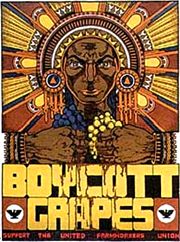 Just Another Poster? Chicano Graphic Arts in California, is the first exhibition and book that explores the Poster Art created by dozens of Chicano Artists in California from the late 1960’s to the present... Graphic art has played a key role in El Movimiento (the Chicano Civil Rights movement), and the poster has been used to educate, agitate, and organize Americans of Mexican descent...
Just Another Poster? Chicano Graphic Arts in California, is the first exhibition and book that explores the Poster Art created by dozens of Chicano Artists in California from the late 1960’s to the present... Graphic art has played a key role in El Movimiento (the Chicano Civil Rights movement), and the poster has been used to educate, agitate, and organize Americans of Mexican descent...
The posters frequently use Mexican icons reworked to express a unique Chicano perspective.
Chicano Poster Art became a means to help preserve and promote a culture largely ignored by the dominant Eurocentric society of the United States. Artists glorified Aztec Gods, Mexican Revolutionaries, the Virgin de Guadalupe, Immigrant Farm Workers, and the experiences of everyday Raza (people)...
Most of the work in the exhibit was produced in association with one of six major Chicano art centers and cooperatives: Royal Chicano Air Force (Sacramento), Galería de la Raza (San Francisco) and La Raza Silkscreen Center/La Raza Graphics (San Francisco), Self-Help Graphics and Art (Los Angeles) and the Mechicano Art Center (Los Angeles), and Centro Cultural de la Raza (San Diego). All but the Galería de La Raza were centers of poster production.
Boycott grapes poster by Xavier Viramontes, 1973, offset lithograph, printed by striking farm workers.
Together for the City We Love
![]() In February 1975, New York City reached the nadir of its financial crisis when underwriters withdrew from a $260 million bond issue, putting the the City on the verge of insolvency. To help generate income, the New York Commerce Commission hired ad agency Wells, Rich and Greene to develop a campaign that would promote New York City and state as a tourist destination. The slogan they came up with: I Love New York. The Commission hired designer Milton Glaser to develop a logo. When the ads came out in 1977, they featured New York celebrities including Frank Sinatra, Morgan Fairchild and Yul Brenner.
In February 1975, New York City reached the nadir of its financial crisis when underwriters withdrew from a $260 million bond issue, putting the the City on the verge of insolvency. To help generate income, the New York Commerce Commission hired ad agency Wells, Rich and Greene to develop a campaign that would promote New York City and state as a tourist destination. The slogan they came up with: I Love New York. The Commission hired designer Milton Glaser to develop a logo. When the ads came out in 1977, they featured New York celebrities including Frank Sinatra, Morgan Fairchild and Yul Brenner.
The campaign was an enormous success, running for 25 years, with no end in sight. (There’s certainly no shortage of fabulous I Love New York merchandise for sale around town.) The logo has become iconic and often imitated.
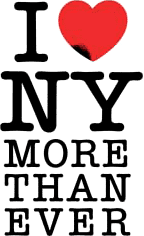 In the aftermath of September 11, 2001, Glaser updated his design by adding a smudge to the lower corner of the heart and the words “More Than Ever.” The image must have struck a chord. It seemed to pop up in every shop window in town. Glaser, who’s taught design at the School of Visual Arts for 40 years, worked with the director of the school to print up posters. Students ran around handing out 5,000 posters, and New York’s papers reprinted the image for their readers to clip and post. Personally, I thought the image was corny, but a step up from all the flag waving. I did experience the incredible comradery of the people of New York City. Many, however, experienced incredible animosity and even violence.
In the aftermath of September 11, 2001, Glaser updated his design by adding a smudge to the lower corner of the heart and the words “More Than Ever.” The image must have struck a chord. It seemed to pop up in every shop window in town. Glaser, who’s taught design at the School of Visual Arts for 40 years, worked with the director of the school to print up posters. Students ran around handing out 5,000 posters, and New York’s papers reprinted the image for their readers to clip and post. Personally, I thought the image was corny, but a step up from all the flag waving. I did experience the incredible comradery of the people of New York City. Many, however, experienced incredible animosity and even violence.
At the bottom of the posters is text that specifically notes that the posters are not for sale. Glaser did make one exception, though, when he allowed WNYC, a public radio station, to sell posters to raise money to replace the broadcast tower and antenna that were destroyed when the towers collapsed. The gesture ultimately raised $190,000.
It’s a year and a half later and the city faces another financial crisis. Glaser has designed the third in a continuing series of messages: “Together for the City We Love.”
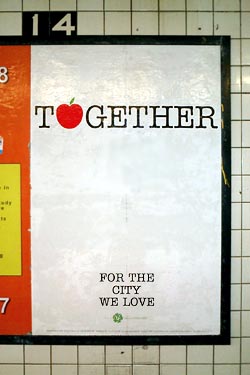 Glaser told the Daily News:
Glaser told the Daily News:
“His new phrase was inspired by the city’s fiscal crisis and the recent threat of a transit strike. Glaser sent City Hall several designs with the slogan, which he says could serve as a ‘rallying cry’ to help New Yorkers bond during tough times.”
When I first saw the new logo in the subway, I was skeptical. As a New Yorker, I will not be bullied into happiness or togetherness. Certainly, when the State sells unity, I wonder who stands to gain. “Community” is often used the gloss over difference and dissent. “You’re either with us, or against us.”
The design, however, is open to interpretation. One could just as easily use it at a block party or mass action. And I’m sure subway riders will note their own impressions on the ad’s generous white space.
As it turns out, the city chose not to use the design. Instead, Glaser and SVA will be publishing it on their own again — the public act of private individual, an educational institution, and its students. SVA also arranged ad space in the subways. The students will distribute the printed posters this weekend.
“The people of NYC seem to be losing that sense of cohesion we felt a year and a half ago,” says Glaser. He hopes the campaign will encourage people to be nicer to each other and may try to use it as a fundraiser for the City to help pay for some of the services being cut. “It’s a drop in the bucket, but it would have symbolic meaning.”
Meanwhile, the city government has plans of its own. Mayor Bloomberg has set up a permanent office and campaign to sell New York to big business and investors and to woo major events. The effort relies less on advertising and more on deals with the private sector and behind-the-scenes lobbying.
It has already brought back Grammy’s and next year’s WNBA All-Star game to New York, but also the Republican National Convention in 2004.
I for one will be out there protesting, together for the city we love.
The Visual Rhetoric of War
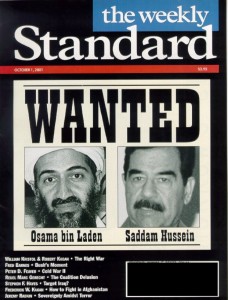
“The linking of the two evils. Unproven by the facts, reality in the image. The Wild West poster does the trick of validating the Bush approach and chosen iconography.”
The Better Rhetor builds on the work of Political Research Associates in this unpacking of the imagery used in a series of Weekly Standard covers.
See also Kate Brigham’s MFA thesis, Decoding Visual Language Elements in News Content, and its prototype Flash piece that allows you to alter design elements of post-September 11 news magazine spreads on the fly. See for yourself how non-verbal messages are expressed, the objectivity of the news is tilted, and the case for war is made by the choice of imagery, its cropping, composition, and color.
Thanks to drapetomaniac for the Better Rhetor link.
Aussie Military Pulls College Ads over Parody
From The Sunday Mail:
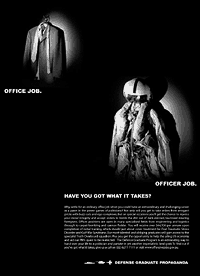 “[Australia’s] Department of Defence appears to have pulled all its advertising from every student newspaper in the country because one Sydney publication made fun of it.
“[Australia’s] Department of Defence appears to have pulled all its advertising from every student newspaper in the country because one Sydney publication made fun of it.
The University of Technology Sydney student newspaper Vertigo ran a satirical ad to counter recruitment advertisements appearing in other publications and voice the editors’ opposition to war on Iraq.
Under the heading, ‘Have you got what it takes?’, the ad reads:
‘Why settle for an ordinary office job when you could have an extraordinary and challenging career as a pawn in the power games of politicians?
‘Not only will you get to take orders from arrogant pricks with buzz-cuts and ego complexes, but on special occasions you’ll get the chance to repress your moral integrity and accept orders to bomb the shit out of dark-skinned, tea towel wearing foreigners.’
Vertigo editor Jano Gibson said that after seeing the ad, the Defence Department pulled all advertising from every student paper in the country.
The move comes at a time when many student newspapers are struggling for financial survival and increasingly reliant upon advertising.
But far from being disappointed, the editors are thrilled that they have eliminated all Defence ads, saying the Government had played right into their hands.
Mr Gibson said Vertigo had already refused ads from the department and was trying to get other student papers to do the same.
‘In effect the Department of Defence has fulfilled our intentions in having a boycott across the rest of Australia,’ he told AAP.
‘We see it as a great victory that students are no longer being inundated with false representations of the defence forces.’”
From the Sydney IndyMedia:
“As an act of solidarity the parody will also be reprinted by Rabelais, the student paper of La Trobe University, and Lot’s Wife, the student publication of Monash University, with more possibly to follow.”
Night Letters
“The Partnership of Nations has secured the Qandahar Airport to ensure that Humanitarian Aid will reach the people of this area. For your own safety stay away.”
Leaflet War Rages in Afghan Countryside
“The war in Afghanistan is not just about bombing mountain hide-outs, it’s also about getting a message out. The result is a leaflet war that has littered the Afghan countryside with thousands of pieces of paper.
On one side are the United States and its allies, who use pamphlets with mugshots of fugitives and pictures of Taliban abuses to warn coalition enemies that there is no escape.
On the other side are the Taliban, al-Qaida and renegade rebel leader Gulbuddin Hekmatyar, whose much more prolific flyers warn foreign soldiers they are targets, or urge Islamic faithful to rise up against them in holy war.
The anti-American pamphlets are called ‘night letters,’ secretly circulated and strewn by the hundreds in towns, villages and countryside. Within the last few weeks, they turned up in the capital of Kabul for the first time.”
The AP story depicts much of the propaganda war centering on women’s bodies — U.S. forces shown searching a young girl vs. a member of the Taliban shown beating a woman.
However, of the U.S. flyers shown here, some are instructional — tune to this radio station, those yellow things are food packets — but most simply hawk moral platitudes and cash money rewards.
Psyops Comics IV: Viet Nam

“Honey, what do they say in those leaflets?”
“They are the same as those wall posters, as well as the announcements on the radio yesterday. The two Communists Ba Luong and Hai Gon are presently hiding our village in order to collect taxes. I am determined to report to the Phoenix Operation Committee because I know their hiding place.”
We’ve seen the CIA use comics to fight the Sandinistas; the FBI to fight the Black Panther Party; and with the Comics Code Authority to portray the CIA, ethnic advancement agencies, and the economically privileged in a positive light for U.S. comics readers. The CIA also used comics during the Vietnam War as part of its psychological operations and counterinsurgency campaign.
The comic book, “Mr. Ba’s Family and the Phoenix Operation,” was prepared and disseminated by U.S. forces in South Viet Nam under Operation Phoenix. Operation Phoenix was designed to assassinate or imprison members and collaborators of the National Liberation Front, the united front that brought together Communists and non-Communists to liberate Viet Nam from foreign control.
“Phoenix offices were set up from Saigon down to the district level. Their functions were to: (1) collate intelligence about the ‘Vietcong Infrastructure’; (2) interrogate civilians picked up at random by military units carrying out sweeps through villages; (3) ‘neutralize’ targeted members of the NLF. This third task was often carried out by CIA-led Vietnamese organized into Provincial Reconnaissance Units.”
The comic the fictional story of “Mr. Ba,” who is conviced and eventually rewarded for informing the U.S. military about where the Viet Cong are hiding in his village.
Read more about the comic or See pages from the comic and an English translation. Note, the page and images load slowly.)
On July 19, 1971, William Colby, the CIA officer in charge of Operation Phoenix, testified before a Subcommittee of the House Committee on Government Operations, that between 1968 and May 1971, 20,587 alleged Vietcong sympathizers were executed as a result of the Phoenix Program. The government of South Vietnam credited Phoenix with 40,994 deaths. Vietnamese who were taken into custody were often tortured before being executed. U.S. military-intelligence officer, K. Barton Osborn testified that none of those ever held for questioning lived through the process. (New York Times, August 3, 1971, p. 10.)
The Memory Hole has posted a collection of CIA documents from the Phoenix Program online.
The Committee to Help Unsell the War
In 1969, Arkansas Senator J. William Fulbright, announced the results of his investigation into the Defense Department’s lavish spending on propaganda and self-promotion during the Vietnam War.
Mitchell Hall writes in Unsell the War: Vietnam and Antiwar Advertising, (Historian, Autumn 1995):
“From 1959 to 1969, the Pentagon’s public relations expenditures increased 1,000 percent to an acknowledged $27.9 million, a figure Fulbright called ‘conservative.’ With this financing and a full-time public information force of 2,800 people, the military enjoyed overwhelming access to the public. In 1968 the navy and marines sent over 2.8 million news releases to 12,000 print and broadcast media outlets, in 1969 armed forces performances ranging from musical groups to aerial demonstrations played to audiences estimated at 20 million, and over 360 commercial and educational television stations used the U.S. Army-produced TV show ‘Big Picture.’ The potential influence on public opinion and foreign policy was enormous.
U.S. presidents from Harry Truman to Richard Nixon had also tried to persuade the public that events in Indochina demanded a U.S. military presence. Their efforts initially succeeded, but by the late 1960s millions of Americans had publicly demonstrated their rejection of a policy that had brought increasing sacrifice, destruction, and stalemate. Nixon’s Vietnamization policy, which gradually removed U.S. ground troops but escalated the bombing, partially defused antiwar activity by early 1971. Decreasing U.S. casualties convinced many people that the war was winding down. Although massive public demonstrations occurred less frequently than before, citizens in the early 1970s continued to work to end the war in numerous and creative ways.
On February 23, 1971, CBS broadcast the documentary “The Selling of the Pentagon.”
“Reiterating many of the points addressed in Fulbright’s report, this hour-long program examined the Defense Department’s public relations efforts that, in addition to recruiting volunteers and providing information, marketed a specific interpretation of the Vietnam War and the cold war to the U.S. public....
The military establishment annually arranged hundreds of public contacts that included shopping mall exhibits, Green Beret hand-to-hand combat demonstrations, and tours by flight teams such as the Thunderbirds. In clear violation of regulations, a select group of colonels avidly promoted the U.S. presence in Vietnam in speeches they gave around the country. The Defense Department also provided weekend guided tours of military installations to VIPs, who could observe war games from a grandstand and personally fire tank guns and artillery.
Films also propagated the military’s ideology. The Pentagon cooperated with Hollywood producers who portrayed the military favorably and had celebrities and journalists narrate some of its own movies....
The Defense Department achieved its widest exposure through the news media. Daily briefings to the national press yielded only carefully selected information from the Pentagon’s public relations division. The armed forces also maintained their own media arm, producing over two million press releases each year. Local newspapers generally snapped up uncritically this flood of news about the awarding of medals and promotions. Military television crews provided combat footage to supplement network coverage but often staged the action. Similarly military officials frequently held pre-interview briefings with soldiers in the field to ensure a standard acceptable story before allowing network TV reporters access to them. CBS questioned the impact on a democratic society and free press of a vast military information system that portrayed violence as glamorous, advertised expensive weapons like cars, and presented biased opinion as fact.”
Ira Nerken, a junior at Yale University studying political science, missed the initial broadcast of ”The Selling of the Pentagon” but read about the controversy it provoked. He decided that the war could be ‘unsold’ to the American public. Print ads had occasionally appeared in leading newspapers, and ad hoc groups produced some radio and television spots, but the advertising world had never been tapped on a large scale.
After discussing his ideas with an instructor at Yale, the instructor introduced him to David McCall, president of LaRoche, McCaffrey & McCall, an ad agency in New York. McCall and James McCaffrey, the agency’s chair, quickly organized a team that produced a poster and letter of explanation seeking support for a campaign to unsell the war. These were sent to 80 executives in 60 agencies.
The initial poster featured a drawing of the Pentagon and the headline, “Help unsell the war.” It read:
“C.B.S. recently devoted an hour to documenting the enormous advertising and public-relations job the Pentagon has done to sell the American public its version of the war. A group of students and faculty at Yale University are asking the men and women of the advertising agency business who disagree with the Pentagon’s version of the war to create advertising in all forms that will help unsell the war.”
The letter closed:
“Needless to say, we are not interested in cheap, superficial, anti-American work, we are interested in thoughtful and honest advertising, created by people who love their country.
I hope you will agree with me that this is a vital contribution which our business can make. If you do not agree, I can understand that, too. But the Pentagon’s side of the story has been ably and massively told. Ours has not.”
 Interested ad executives were invited to briefing at Yale University on April 3, 1971.
Interested ad executives were invited to briefing at Yale University on April 3, 1971.
“Over two hundred New York advertising people attended the early April briefing at Yale’s law school auditorium. Paul Warnke, former assistant secretary of defense, and Morton Halperin, former deputy assistant secretary of defense, explained Nixon’s Vietnam policies, and both urged setting a deadline for total withdrawal of U.S. troops. A representative of Vietnam Veterans Against the War discussed war crimes and problems veterans faced. A member of Concerned Asian Scholars described corruption within the Saigon government and the spreading antiwar feeling in South Vietnam. A person from the Herbicide Assessment Commission to South Vietnam showed slides of defoliation and crop destruction, and a former ABC correspondent in Vietnam detailed the strained relationship between the press and the military. Perhaps the most influential speaker was Milton Rosenberg, professor of social psychology from the University of Chicago. He identified the constituencies most ambivalent about the war and the arguments most likely to turn them against it: the deaths of U.S. troops, the economic consequences for the United States, and the creation of national discord.”
After the briefing, the attendees were asked to produce ads to be reviewed on May 1 by a panel that included Kingman Erewster, president of Yale; Mort Halpern, former Deputy Assistant Secretary of Defense; Dr. Edwin Reischauer, former Ambassador to Japan, and Gen. David M. Shoup of the United States Marine Corps (retired.) The panel would evaluate the ads and eliminate those that were inaccurate, unfair, or inferior.
On Memorial Day, May 31, the ads and commercials were to be displayed and distributed to the media to run as a public service.
Over 300 writers, artists, directors, and producers from nearly 50 ad agencies contributed an estimated $1 million of time and expenses. As of June 8, 1971, 125 print ads, 33 TV commercials and 31 radio spots had been produced. Given the expense of reproducing the ads, only a handful were sent to media outlets.
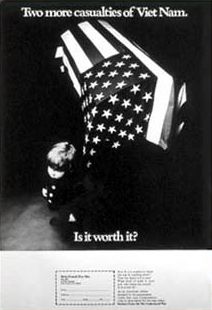 Though the Committee never did convince the major broadcast networks to air the ads, over 100 TV stations and 350 locally owned radio stations around the U.S. did run the spots. During the summer of 71, Nerken was able to arrange free time on 285 billboards around the country. Many of the ads urged people to elect representatives who would vote to end the war by the end of the year.
Though the Committee never did convince the major broadcast networks to air the ads, over 100 TV stations and 350 locally owned radio stations around the U.S. did run the spots. During the summer of 71, Nerken was able to arrange free time on 285 billboards around the country. Many of the ads urged people to elect representatives who would vote to end the war by the end of the year.
“With its attention focused on production rather than marketing, Unsell encountered additional problems inherent in the campaign. It lacked a built-in constituency or the organizational resources to conduct a national distribution effort. Local media felt little pressure to run ads offered by mail from New York. The result was a relative lack of success in getting messages on the air and in print. Because many ads focused on U.S. casualties, the sell became harder as Vietnamization brought more U.S. troops home in favor of an escalated air war, diluting one of the Unsell campaign’s central themes.”
In 1972, the expense and demands of the campaign ultimately led to its transfer to Clergy and Laymen Concerned, the nation’s largest religiously oriented antiwar organization. The focus of ad production also shifted from New York City to Hollywood. The CALC’s network of local chapters were also able to decentralize the task of contacting local media for free time and space. National organizations such as the American Friends Service Committee, Another Mother For Peace, and the Fellowship of Reconciliation also urged their members to get involved in the campaign.
In addition to the decline in U.S. casualties, the ongoing financial burden of the campaign and the 1972 presidential election slowed the momentum of the project which ultimately ended after the reelection of President Nixon and his announcement in January 1973 of an accord with North Viet Nam to end American involvement in Indochina.
The Library of Congress has several thumbnail images of posters produced by the Committee. Click on ‘Preview Images.’
A Threat to Peace, U.S.A.
“The Indypendent - the monthly newspaper of the NYC-Indymedia Center proudly presents ... A Threat to Peace - a handy poster-sized color map of U.S. terrorist infrastructure.
Whether you’re a budding weapons inspector or just a trivia buff, A Threat to Peace can give you the scoop on nuclear manufacturing facilities, chemical and biochemical weapons facilities, weapons manufacturers, nuclear testing and launch sites, and much, much more.”
Download the poster or order one.
Points of interest include:
- Chemical Weapons
- Domestic War Criminals
- Imported War Criminals
- Private Mercenary Companies
- Military Sites
- Biological Weapons
- Nuclear Weapons
- Terrorist Training Camps
- Rest & Recreation
- Militarization of Space
- Major Weapons Makers
- Universities, Policy Institutes & Think Tanks
- Nuclear Facilities
- Ballistic Missile Defense


